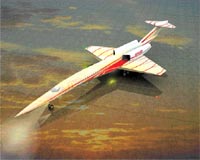Revisions to the design of Aerion's supersonic business jet will be announced today after low-speed windtunnel testing confirmed performance estimates but uncovered a potential deep-stall problem with the original T tail.

Meanwhile, the company, which needs risk-sharing partners to certificate and produce the aircraft, has completed a detailed study indicating a market for 250 aircraft over 10-12 years, even for an aircraft costing $80 million and limited to Mach 0.98 over land.
Windtunnel
Aerion conducted windtunnel tests of an 8% model as part of Cycle 2 of its Phase 1 preliminary design effort, set to be completed by September. The low-speed tests at the University of Washington confirmed the projected 1,830m (6,000ft) balanced field length at the 41,000kg (90,000lb) take-off weight of the initial 7,400km (4,000nm) range version of the M1.5-1.6 aircraft, says chief operating officer Mike Henderson.
Design changes include raising the cockpit and lowering the nose to improve visibility; relocating the nosewheel to reduce turn radius; round rather than two dimensional inlets to improve performance; and strake, wingtip and flap-design refinements.
Blanking of the T tail in deep stall will result in the move to a Dassault Falcon-style cruciform tail or relocation of the horizontal stabiliser to the aft fuselage, depending on high-speed tests, says Henderson.
The change to a zero-sweep vertical stabiliser will allow Aerion to achieve the same supersonic laminar flow on the fin as it does on the wing and tailplane, and which is key to the aircraft's ability to cruise at boom-free transonic speed over land without loss of range. "We know we will meet our 4,000nm goal with the initial aircraft," says Henderson.
A follow-on aircraft is planned with 550-900km more range, 43,000-44,500kg take-off weight and 1,980m field length using the full thrust potential of the Pratt & Whitney JT8D engines. Completion of preliminary design and the market study are key to Aerion's plans to sign partners. It is already sharing data with a peer group of US and European original equipment manufacturers.
"Our goal is to show the aircraft is solid," says Henderson. "At the end of Cycle 2, when we confirm there are no aerodynamic or physical showstoppers, we can go out and attract good risk-sharing partners."
Aiming
Aerion is aiming for certification in four years, or 2011 at the earliest. A "conjoint analysis" has been conducted to measure the market's sensitivity to aircraft range, price, cabin size and the ability to fly overland supersonically, says vice-chairman Brian Barents.
The study showed a substantial number of customers would buy the Aerion aircraft rather than wait for a low-boom quiet supersonic business jet, he says. The study identified a market for 220-260 aircraft over 10 years, with 20% of sales coming from fractional ownership. This excluded head-of-state and military customers. The survey reached about 13% of operators of super mid-size and larger business jets, says Barents, and indicated a supersonic aircraft could take about 12% of that market.
Source: Flight Daily News
















